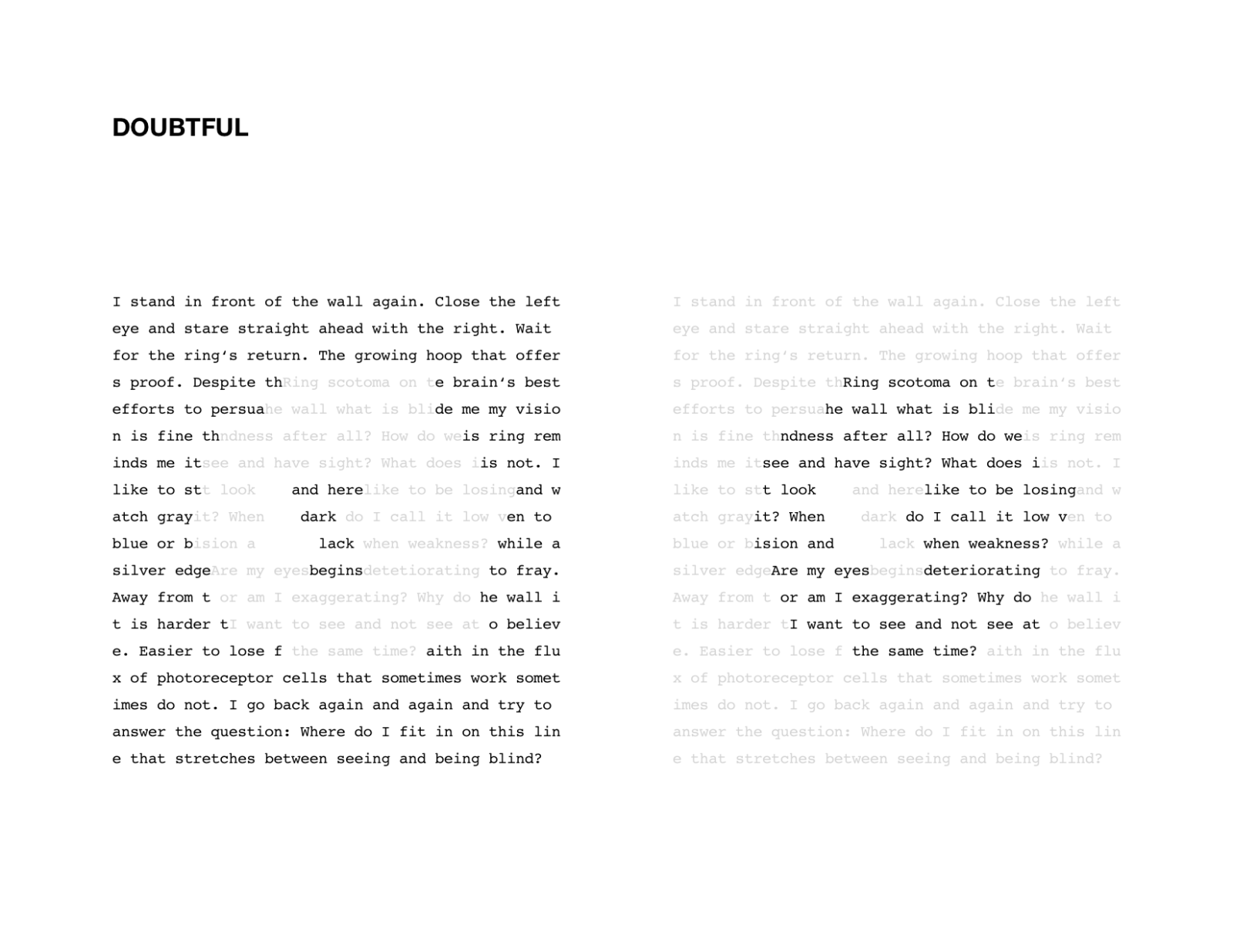
Nominated, along with “Doubtful,” for a Pushcart Prize.
Formless text for the poem/s:
Poem 1 = entire grid
Poem 2 = inner circle, central vision that’s left
Poem 3 = Blind Ring
Poem 1
I stand in front of the wall again. Close the left eye and stare straight ahead with the right. Wait for the ring’s return. The growing hoop that offers proof. Despite the brain’s best efforts to persuade me my vision is fine this ring remains me it is not. I like to stand here and watch gray darken to blue or black while a silver edge begins to fray. Away from the wall it is harder to believe. Easier to lose faith in the flux of photoreceptor cells that sometimes work sometimes do not. I go back again and again and try to answer the question: Where do I fit in on this line that stretches between seeing and being blind?
Poem 2
and here
dark
lack
begins
Poem 3
Ring scotoma on the wall what is blindness after all? How do we see and have sight? What does it look like to be losing it? When do I call it low vision and when weakness? Are my eyes deteriorating or am I exaggerating? What do I want to see and not see at the same time?
Resources and Additional Thoughts
Most often, not being able to see normally doesn’t mean you can’t see anything. According to the Royal National Institute of Blind People (RNIB), 93% of blind and partially sighted people can see something. The line between seeing and not-seeing is not fixed and shifts over time, especially as more people get older and develop eye disorders like macular degeneration, glaucoma. Many people (myself included, before I started to lose my vision and was told I could become legally blind), do not know this and think of a strict binary: you either can see or you are blind.
An image of a woman holding a white cane whilst using her mobile phone recently went viral on social media, and it highlighted many of the misconceptions that the general public have around the lives of blind and partially sighted people. Many blind and partially sighted people responded by sharing their own photos with the hashtag #BlindPeopleUsePhones, saying how they use theirs.
In fact, there’s no reason why someone couldn’t have a mobile phone and also use a cane (or indeed, a guide dog). Most smartphones have built-in accessibility features like voice control, magnification and screen readers. Members of our community have told us they find them invaluable for things like planning journeys, sending messages and emails and checking social media.
How I See
And some days I would rather bump into people than bump into their responses to blindness. I understand their confusion—they see my un-tinted eyeglasses as a badge of vision and my white cane as a badge of blindness. They seem to associate blindness with slowness, so they are befuddled by my quick, confident stride with my cane. I have had years to adjust to the shifting non-binary nature of blindness. Most people I bump into are coming upon it fresh.
In Light of a White Cane/ Naomi Cohn
This line, “I had years to adjust to the shifting non-binary nature of blindness,” speaks to my doubt. At this point, so early in my awareness of vision loss (and so early into its great decline), I have not yet had years to adjust. Adjusting to the shifting is exhausting and scary and breeds doubt–some days I can see, some I can’t. I am learning to deal with this uncertainty.
from a log entry on sept. 17, 2020
How bad is my vision? Part of my struggle right now is that I see much worse than a “normally” sighted person but not as poorly as someone who is legally blind. I am not yet blind. Even as I want to express my feelings about this in-between stage, I sometimes feel like an imposter or someone who might be exaggerating their bad vision. Then I remember how I can’t see faces or follow anything that happens on commercials. How I can’t tell if a walker on the sidewalk is heading towards me or away. How I seem to be needing brighter and brighter light to see words or the lines on the page of a notebook.
from a log entry on sept 18, 2020
Much of the time, even for me with my increasingly bad vision, the brain’s tricks for filling in gaps and working with incomplete visual data are hidden. I might see things a little fuzzier but I still see them. Unless I concentrate, I can’t see the ring scotoma in my central vision. There is no dark black ring on the page when I’m reading. But it’s there and when I found it by staring intently at a blank wall, I was astonished and fascinated. I was also relieved. Here, with this ring, was evidence that my vision is declining, that I’m not making this bad vision thing up. Because my brain is so good at compensating and performing magic tricks, it can be easy for me to think my eyes are better than they are, that I’m seeing more than I am.